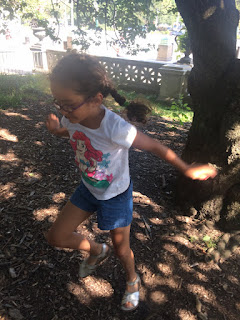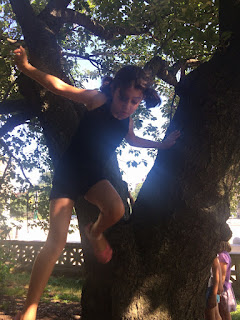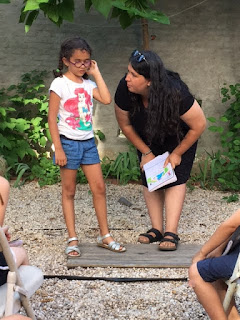We have no words, though we will try and assemble some for this last blog entry, which we write with a heavy but overflowing heart. Yesterday was the final day of Elm Tree Poetry (for now), and we closed it out with what we knew would be a special event, but we had no idea just how extraordinary. Our reading, hosted generously by Unnameable Books, was an amazing way to wrap up our program, as it honored our amazing poets and celebrated their parents' dedication to our program. Many of them were instrumental in making sure Elm Tree became a reality this summer, and for that we are grateful.
It is, needless to say, a vulnerable act to stand in front of a crowd and read your poetry aloud. The bravery of our young writers—who, until then, had been reading and writing exclusively with each other in the park—is not negligible. We were beaming with pride watching our kiddos up there, and were honored to stand alongside them and read some of their work when asked. We knew that their words would do most of the work for us, and we were right.
But we're getting a little ahead of ourselves. Our day started all other days at Elm Tree have, with the kids getting dropped off and climbing trees in the entrance by Prospect Park. Our last day served as a great catalyst to fulfill some bucket list items, which for a few of the kids meant facing their fear of jumping (safely!) down from one of the trees. Thanks to a ton of supportive cheering from fellow kiddos, our poets managed to finally face their fears and make the leap. The cheering we heard from around that tree was echoed later as our kiddos rehearsed for the reading, and were supported by their new friends with (loud) vigor.
The Camperdown Elm is a bit of an ecological anomaly. The tree is part of the weeping elm family, born from an elm found on the estate of the Earl of Camperdown in Scotland. An infected tree root caused the estate to chop down most of the elms, but the remaining branches were used to plant the Camperdown Elm in Prospect Park, one of the last remaining trees of its kind. Due to the infected root, the tree itself cannot reproduce by itself, but this has served as a tiny miracle since that same infection is said to have saved the elm from the Dutch elm disease that spread throughout the United States in 1928.
While Romy and (co-founder) Sally were flipping through a guidebook of Prospect Park, they learned this story and decided to honor Marianne Moore in much the same way that Moore immortalized the tree in her poem, "The Camperdown Elm". The tree is located near the Boathouse, and her poem is below:
The Camperdown Elm
I think, in connection with this weeping elm,
of “Kindred Spirits” at the edge of a rockledge
overlooking a stream:
Thanatopsis-invoking tree-loving Bryant
conversing with Thomas Cole
in Asher Durand’s painting of them
under the filigree of an elm overhead.
No doubt they had seen other trees — lindens,
maples and sycamores, oaks and the Paris
street-tree, the horse-chestnut; but imagine
their rapture, had they come on the Camperdown elm’s
massiveness and “the intricate pattern of its branches,”
arching high, curving low, in its mist of fine twigs.
The Bartlett tree-cavity specialist saw it
and thrust his arm the whole length of the hollowness
of its torso and there were six small cavities also.
Props are needed and tree-food. It is still leafing;
still there. Mortal though. We must save it. It is
our crowning curio.
We decided to spend our last day nestled under the Camperdown Elm, so the kiddos grabbed the tapestry themselves and laid it out in the shade, following our routine without prompting. We told the kids that this was the tree our program was named for, and began to have a discussion about the rods holding the tree together, the rope keeping the branches afloat, the wooden posts raising up the tree's silhouette. Annabel immediately started to speak in metaphors about the tree as we the kids began to eat their snacks. "Every leaf is a story," she suddenly said aloud. She continued on from there. Rod and Romy decided immediately that Friday would be dedicated to a freeform day, allowing the children to be inspired by the elm to write in whatever form spoke to them. This was very much inspired by Annabel's sudden desire to place the tree in a poetic context. It became clear to us that at this point in the program, the kids didn't need prodding: they were inspired on their own.
It didn't surprise us that a student who had been working with us for both sessions was the one to lead the exercise. As Annabel watched the other kiddos begin to write, many of them using her form as a launching pad for their own work, she said in astonishment, "I have never felt this proud." She even took to transcribing Ajay's work for him, proving that she's every bit the teacher as she is a poet. We could imagine a child like Annabel—someone with so much energy and spirit—helping us run Elm Tree one day.
Once the kids felt they had reached the end of their poem, we turned our sharing of the work into a rehearsal for the reading. The kids went up one by one and read their poems aloud as we worked on projection, enunciation, speed and intention. Once we had gone through the reading order and had everybody practice, we broke for lunch, where Romy and Rod decided that we were going to allow the kids to enjoy each other's company and play for the rest of the day. The poems they had written in the morning were such moving odes to both the program and the tree that gave us its name. With the reading coming up in a few hours, we wanted to give them a mental break to frolic.
We told the kids the above history of the tree before and read them Marianne Moore's poem. With that, we headed toward the Natural Playground for some closing day fun.
Some parents sent us a few photos of the reading — unfortunately, not everybody is represented, as Romy and Rod were unable to take the normal fury of photos during their duties as hosts. But hopefully you all snapped or videoed your kiddos up on our makeshift stage.
The past two weeks have been, as one parent put it, a truly "mind-bending experience". Watching the kids grow in a matter of days has been the surest sign that education should not exist in stasis. Learning is, like the plant life that surrounded us for the last ten days, a living, breathing thing. With enough care, both individual and collective, it grows tenfold. The concepts we worked with during our program were at times extremely complex, and we were often asking the children to "unlearn" certain presumptions about writing just as much as we were attempting to teach them new tools. By giving them autonomy in their learning, they made us better teachers. And for that, we are forever grateful.
The pride in their faces after the reading was an image we wont soon shake. We hope you saw it too.
With love, always, always and always,
Romy & Rod







































No comments:
Post a Comment